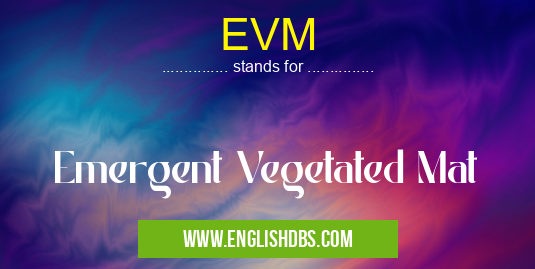What does EVM mean in UNCLASSIFIED
EVM stands for Emergent Vegetated Mat. It is a relatively new technology used in coastal restoration and erosion control. EVMs are typically made from a biodegradable material, such as jute or coir, and are planted with a variety of native vegetation. Once established, EVMs can help to stabilize shorelines, reduce erosion, and improve water quality.

EVM meaning in Unclassified in Miscellaneous
EVM mostly used in an acronym Unclassified in Category Miscellaneous that means Emergent Vegetated Mat
Shorthand: EVM,
Full Form: Emergent Vegetated Mat
For more information of "Emergent Vegetated Mat", see the section below.
How EVMs Work
EVMs work by mimicking the natural processes that occur in healthy coastal ecosystems. The vegetation on the mats helps to trap sediment and slow down water flow, which in turn reduces erosion. The roots of the plants also help to hold the mats in place and create a stable substrate for other marine life.
Benefits of EVMs
EVMs offer a number of benefits over traditional erosion control methods, such as:
- Cost-effective: EVMs are relatively inexpensive to install and maintain.
- Environmentally friendly: EVMs are made from biodegradable materials and do not harm marine life.
- Effective: EVMs have been shown to be effective in reducing erosion and improving water quality.
Applications of EVMs
EVMs are used in a variety of applications, including:
- Coastal restoration: EVMs can be used to restore damaged shorelines and create new habitat for marine life.
- Erosion control: EVMs can be used to reduce erosion on beaches, cliffs, and riverbanks.
- Water quality improvement: EVMs can help to improve water quality by filtering pollutants and reducing sediment runoff.
Essential Questions and Answers on Emergent Vegetated Mat in "MISCELLANEOUS»UNFILED"
What is an Emergent Vegetated Mat (EVM)?
An Emergent Vegetated Mat (EVM) is a cellular confinement system that is planted with vegetation to create a living erosion control solution for slopes, streambanks, and shorelines. It consists of a three-dimensional, honeycomb-like structure made from biodegradable or geosynthetic materials that is filled with soil and vegetation. The vegetation establishes a dense root system that binds the soil together, preventing erosion and promoting slope stability.
What are the benefits of using an EVM?
EVMs offer several benefits, including:
- Enhanced erosion control: The dense vegetation and interlocking cells of an EVM effectively trap sediment and prevent soil loss, making it an effective erosion control solution.
- Slope stabilization: The root systems of the vegetation within the EVM bind the soil together, increasing slope stability and reducing the risk of landslides.
- Water filtration: The vegetation and soil within the EVM filter runoff water, removing pollutants and improving water quality.
- Habitat creation: The vegetation in an EVM provides habitat for wildlife, including insects, birds, and small mammals.
- Aesthetic appeal: EVMs can enhance the aesthetic appeal of slopes and shorelines by creating a natural-looking, vegetated surface.
What types of vegetation are used in EVMs?
The type of vegetation used in an EVM depends on the specific site conditions and desired outcomes. Common vegetation choices include:
- Grasses: Grasses are often used in EVMs due to their dense root systems and ability to tolerate a wide range of conditions.
- Sedges: Sedges are similar to grasses but have a more fibrous root system, making them ideal for areas with high erosion potential.
- Rushes: Rushes are plants that typically grow in wet areas and can tolerate fluctuating water levels.
- Forbs: Forbs are broadleaf plants that add diversity to the vegetation and provide a food source for wildlife.
- Shrubs: Shrubs can be used in EVMs to provide additional stability and create a more natural appearance.
How are EVMs installed?
EVMs are typically installed by laying the cellular confinement system on a prepared slope or shoreline. The cells are then filled with soil and vegetation. The specific installation methods may vary depending on the site conditions and the type of EVM used.
Final Words: EVMs are a promising new technology that can be used to address a variety of coastal challenges. They are cost-effective, environmentally friendly, and effective. As more research is conducted on EVMs, their use is likely to become more widespread.
EVM also stands for: |
|
| All stands for EVM |
